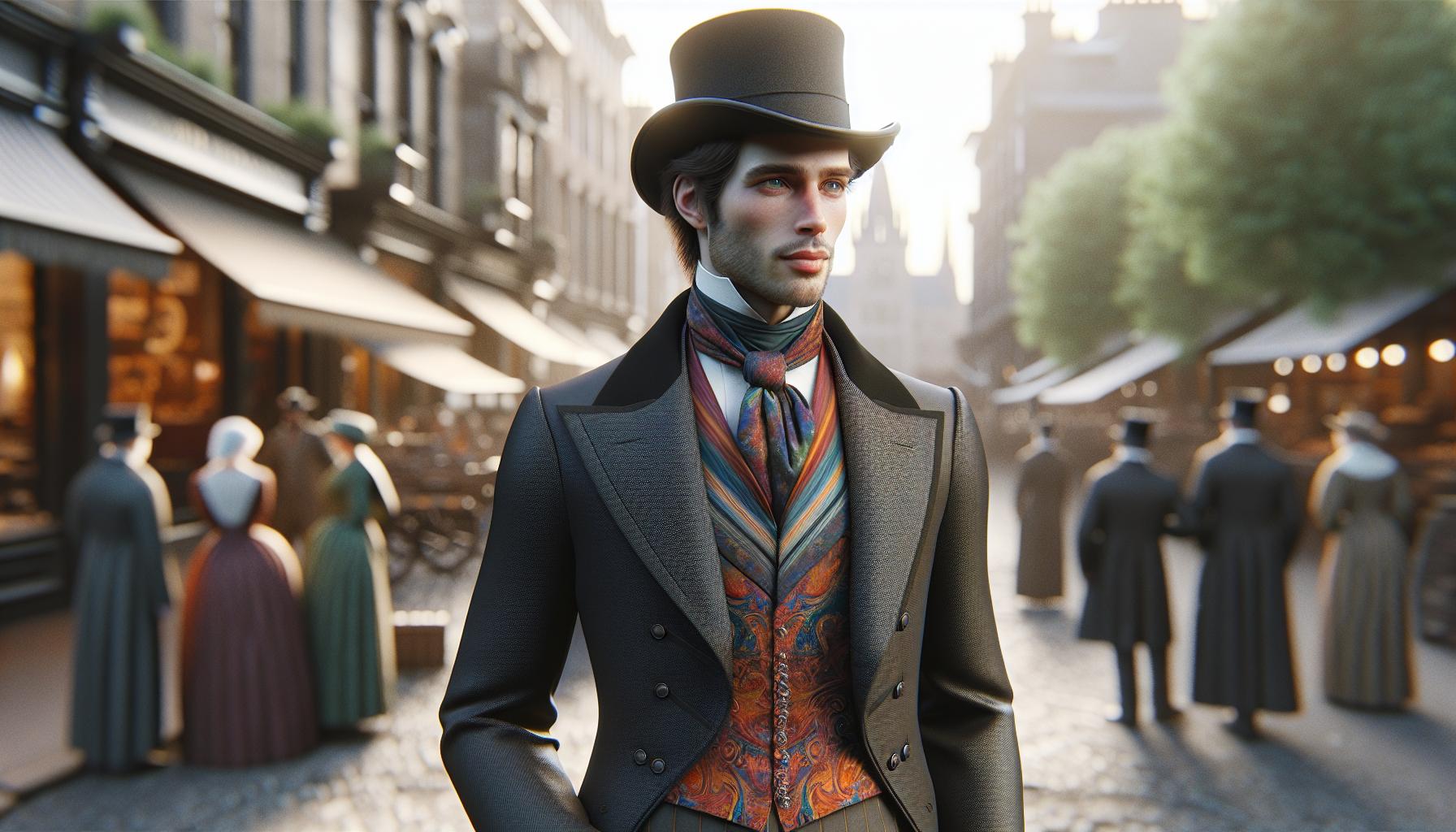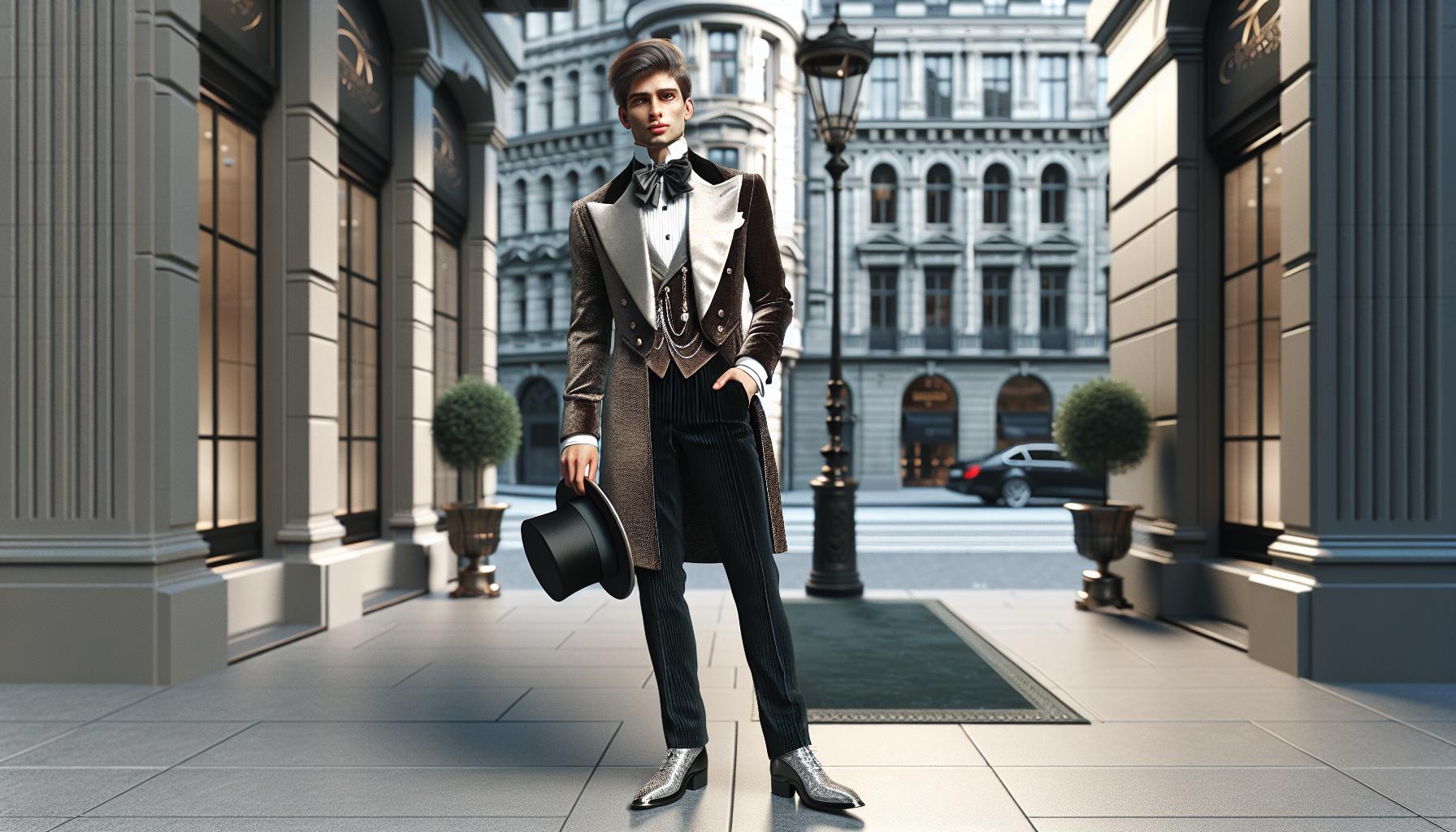Step into the world of 19th century men’s fashion, where style was as bold as a peacock and just as colorful. Picture gentlemen strutting about in tailcoats that could make even the most refined peacock blush. From dapper waistcoats to trousers that seemed to have a mind of their own, this era was a playground for the sartorially adventurous.
19th Century Men’s Fashion
19th century men’s fashion showcased a transformative journey marked by elegance and distinct styles. Tailcoats dominated the era’s formal wear, featuring a fitted silhouette that accentuated the shoulders and tapered at the waist. Waistcoats played a crucial role in adding color and texture, often embroidered or decorated with intricate patterns.
Trousers transitioned from breeches worn in the 18th century to long, tailored pants that offered a more modern appearance. Fabrics such as wool and cotton were popular, providing comfort and durability for everyday wear.
Accessories also marked this period, with top hats emerging as a fashionable statement. Pocket watches served both functionality and style, often paired with ornate chains. Gloves became essential for formal occasions, enhancing the gentlemen’s overall appearance.
Colors varied throughout the century, with the early part characterized by bright shades and patterns. The mid to late 1800s saw darker, more muted tones as the Victorian style took hold.
Footwear completed the ensemble, with ankle boots often preferred for both casual and formal situations. Leather, commonly used, allowed for both elegance and ease of movement.
Overall, 19th century men’s fashion reflected societal changes and cultural influences. The focus on tailoring and personal style established a fashion foundation that would deeply influence future generations. Each piece worn told a story, emphasizing individuality amidst the era’s evolving norms.
Key Trends And Styles

19th century men’s fashion displayed distinct trends and styles throughout the century, reflecting evolving aesthetics and societal norms.
Early 19th Century
Early in the 19th century, fashion focused on an elegant silhouette. Tailcoats featured a fitted design that flared at the back, enhancing the overall shape. Waistcoats in vivid colors showcased intricate patterns, adding vibrancy to ensembles. Trousers transitioned from knee-breeches to full-length styles, made from lightweight fabrics. Accessories, such as cravats and top hats, completed looks and emphasized status. Rich colors like deep blues and bright reds were common during this period.
Mid 19th Century
During the mid-19th century, fashion saw a shift towards more structured designs. The frock coat emerged, characterized by its knee-length cut and formal appearance. Waistcoats continued to thrive in elaborate fabrics, with patterns that reflected personal taste. Trousers remained tailored yet became wider, enhancing comfort. This period introduced accessories like pocket watches and gloves, signifying gentlemanly refinement. Darker and muted tones began to dominate, aligning with Victorian tastes.
Late 19th Century
In the late 19th century, fashion embraced practicality while maintaining style. Sack suits gained popularity, offering an easygoing alternative to the more restrictive designs. The bowler hat emerged as a casual accessory, reflecting an evolving societal attitude. Trousers became standardized in cut and fabric, emphasizing functionality without sacrificing elegance. Patterns and textures in fabrics diversified, catering to individual expressions. This period marked a significant departure from earlier extravagance, welcoming a more modern aesthetic.
Fabrics And Materials

Fabrics and materials played a crucial role in 19th century men’s fashion, influencing styles and comfort. Various textiles marked different periods, from luxurious to practical.
Common Fabrics
Wool emerged as a dominant fabric, favored for its durability and warmth. Cotton gained popularity for its lightness, especially in summer attire. Linen also found its place, prized for breathability. Silk provided elegance and was often used in waistcoats, showcasing intricate patterns. Brocade became fashionable for evening wear, featuring rich textures and vibrant designs. Overall, these fabrics offered varied options, catering to the tastes and needs of gentlemen in this dynamic era.
Innovations In Textiles
Technological advancements transformed textile production. The introduction of the Jacquard loom allowed for intricate woven patterns, enhancing garment designs. New dyeing techniques contributed to a broader color palette, with dyes becoming more vibrant and stable. Synthetic dyes began to emerge toward the end of the century, revolutionizing color accessibility. Additionally, the mechanization of spinning and weaving increased fabric availability, making fashionable textiles more affordable. These innovations significantly impacted how men dressed, promoting both creativity and individuality within fashion.
Influence Of Social Factors

19th century men’s fashion reflected significant social dynamics, including class distinctions and cultural influences which shaped trends and styles.
Class Distinctions
Class distinctions played a pivotal role in shaping 19th century men’s fashion. Wealthy gentlemen often showcased their status through elaborate garments. Tailcoats for affluent individuals featured luxurious fabrics and detailed craftsmanship. Accessories, such as silk cravats and polished shoes, further indicated social standing. In contrast, working-class men opted for more practical clothing, focusing on function over flair. Ready-to-wear clothing emerged, giving lower classes access to fashionable styles at lower costs. This differentiation in apparel highlighted the growing divide between social classes throughout the century.
Cultural Influences
Cultural influences significantly impacted 19th century men’s fashion. Political movements, like the Industrial Revolution, altered how and what people wore. Rising urbanization led to increased exposure to diverse styles and aesthetics. Inspired by art and literature, many gentlemen adopted sartorial choices reflecting contemporary themes and ideas. The Victorian ethos, with its emphasis on propriety and restraint, dictated more conservative fashion choices. In this era, menswear embraced conformity while allowing for slight individuality, showcasing a delicate balance between societal expectations and personal expression.
Iconic Figures In 19th Century Men’s Fashion
Prominent figures significantly shaped 19th century men’s fashion through their unique styles and public personas. Beau Brummell, often regarded as the father of modern men’s fashion, transformed style with his focus on tailoring, emphasizing the importance of fit and elegance. His endorsement of understated yet refined attire set a precedent for future generations.
Charles Dickens, though primarily known as an author, influenced fashion through his vivid character descriptions. His representations of gentlemen propelled specific trends, encouraging fashionable attire among the middle and upper classes. In his novels, characters often wore vivid waistcoats and refined cravats, effectively contributing to sartorial culture.
Prince Albert, the husband of Queen Victoria, also impacted men’s fashion during the mid-19th century. His preference for structured frock coats and formal wear popularized these styles, influencing men’s wardrobes across Europe. The shift toward practicality in the late 19th century allowed Prince Albert’s emphasis on decent presentation to resonate with broader audiences.
Military figures, like those in the British Army, showcased distinctive uniforms that affected civilian fashion choices. The tailored nature of military attire inspired civilian adaptations, particularly the popularity of tailored jackets and trousers. Such styles influenced both formal and casual wear as society became more modernized.
Lastly, dandyism emerged as a countercultural movement, promoting individualism and flamboyance in fashion. Iconic dandies, including Oscar Wilde, highlighted colorful fabrics and extravagant accessories, pushing against societal norms. Their bold choices paved the way for artistic self-expression in clothing, impacting subsequent fashion movements.
Collectively, these influential figures shaped 19th century men’s fashion, reflecting social dynamics, cultural evolution, and shifting aesthetics. Each contributed to a dynamic sartorial landscape, setting the stage for future trends.
Style and Identity
19th century men’s fashion embodies a fascinating evolution of style and identity. From the flamboyant tailcoats of early decades to the practical sack suits of later years, each era reflects changing societal norms and individual expression. The influence of key figures and technological advancements shaped a vibrant sartorial landscape that combined elegance with functionality.
This period not only marked a shift in aesthetics but also highlighted the growing accessibility of fashion across social classes. As men navigated their identities through clothing, they laid the groundwork for modern menswear, showcasing the enduring impact of 19th century trends on contemporary styles.

